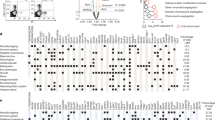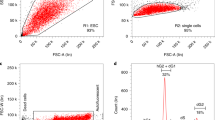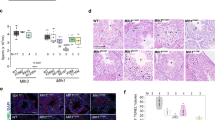Abstract
Phenotype-driven recessive genetic screens in diploid organisms require a strategy to render the mutation homozygous. Although homozygous mutant mice can be generated by breeding, a reliable method to make homozygous mutations in cultured cells has not been available, limiting recessive screens in culture. Cultured embryonic stem (ES) cells1 provide access to all of the genes required to elaborate the fundamental components and physiological systems of a mammalian cell. Here we have exploited the high rate of mitotic recombination in Bloom's syndrome protein (Blm)-deficient ES2 cells to generate a genome-wide library of homozygous mutant cells from heterozygous mutations induced with a revertible gene trap3 retrovirus. We have screened this library for cells with defects in DNA mismatch repair (MMR), a system that detects and repairs base–base mismatches4. We demonstrate the recovery of cells with homozygous mutations in known and novel MMR genes. We identified Dnmt1(ref. 5) as a novel MMR gene and confirmed that Dnmt1-deficient ES cells exhibit micro-satellite instability6, providing a mechanistic explanation for the role of Dnmt1 in cancer. The combination of insertional mutagenesis in Blm-deficient ES cells establishes a new approach for phenotype-based recessive genetic screens in ES cells.
This is a preview of subscription content, access via your institution
Access options
Subscribe to this journal
Receive 51 print issues and online access
$199.00 per year
only $3.90 per issue
Buy this article
- Purchase on Springer Link
- Instant access to full article PDF
Prices may be subject to local taxes which are calculated during checkout




Similar content being viewed by others
References
Evans, M. J. & Kaufman, M. H. Establishment in culture of pluripotential cells from mouse embryos. Nature 292, 154–156 (1981)
Luo, G. et al. Cancer predisposition caused by elevated mitotic recombination in Bloom mice. Nature Genet. 26, 424–429 (2000)
Ishida, Y. & Leder, P. RET: a poly A-trap retrovirus vector for reversible disruption and expression monitoring of genes in living cells. Nucleic Acids Res. 27, e35 (1999)
Buermeyer, A. B., Deschenes, S. M., Baker, S. M. & Liskay, R. M. Mammalian DNA mismatch repair. Annu. Rev. Genet. 33, 533–564 (1999)
Li, E., Bestor, T. H. & Jaenisch, R. Targeted mutation of the DNA methyltransferase gene results in embryonic lethality. Cell 69, 915–926 (1992)
Strand, M., Prolla, T. A., Liskay, R. M. & Petes, T. D. Destabilization of tracts of simple repetitive DNA in yeast by mutations affecting DNA mismatch repair. Nature 365, 274–276 (1993) [Erratum in Nature (368), 569 (1994)]
Ellis, N. A. et al. The Bloom's syndrome gene product is homologous to RecQ helicases. Cell 83, 655–666 (1995)
Groden, J., Nakamura, Y. & German, J. Molecular evidence that homologous recombination occurs in proliferating human somatic cells. Proc. Natl Acad. Sci. USA 87, 4315–4319 (1990)
Stryke, D. et al. BayGenomics: a resource of insertional mutations in mouse embryonic stem cells. Nucleic Acids Res. 31, 278–281 (2003)
Friedrich, G. & Soriano, P. Promoter traps in embryonic stem cells: a genetic screen to identify and mutate developmental genes in mice. Genes Dev. 55, 1513–1523 (1991)
Modrich, P. & Lahue, R. Mismatch repair in replication fidelity, genetic recombination, and cancer biology. Annu. Rev. Biochem. 65, 101–133 (1996)
Fishel, R. et al. The human mutator gene homolog MSH2 and its association with hereditary nonpolyposis colon cancer. Cell 75, 1027–1038 (1993)
Branch, P., Aquilina, G., Bignami, M. & Karran, P. Defective mismatch binding and a mutator phenotype in cells tolerant to DNA damage. Nature 362, 652–654 (1993)
Swann, P. F. et al. Role of postreplicative DNA mismatch repair in the cytotoxic action of thioguanine. Science 273, 1109–1111 (1996)
Abuin, A., Zhang, H. & Bradley, A. Genetic analysis of mouse embryonic stem cells bearing Msh3 and Msh2 single and compound mutations. Mol. Cell. Biol. 20, 149–157 (2000)
Kuehn, M. R., Bradley, A., Robertson, E. J. & Evans, M. J. A potential animal model for Lesch–Nyhan syndrome through introduction of HPRT mutations into mice. Nature 326, 295–298 (1987)
Dong, J. et al. Growth differentiation factor-9 is required during early ovarian folliculogenesis. Nature 383, 531–535 (1996)
Mikkers, H. High-throughput retroviral tagging to identify components of specific signaling pathways in cancer. Nature Genet. 32, 153–159 (2002) [Erratum in Nature Genet. 32, 459 (2002)]
Palombo, F. et al. GTBP, a 160-kilodalton protein essential for mismatch binding activity in human cells. Science 268, 1912–1914 (1995)
Papadopoulos, N. et al. Mutations of GTBP in genetically unstable cells. Science 268, 1915–1917 (1995)
Zambrowicz, B. P. et al. Disruption of overlapping transcripts in the ROSA beta geo 26 gene trap strain leads to widespread expression of beta-galactosidase in mouse embryos and hematopoietic cells. Proc. Natl Acad. Sci. USA 94, 3789–3794 (1997)
Chen, R. Z. et al. DNA hypomethylation leads to elevated mutation rates. Nature 395, 89–93 (1998)
Gaudet, F. et al. Induction of tumors in mice by genomic hypomethylation. Science 300, 489–492 (2003)
Eden, A., Gaudet, F., Waghmare, A. & Jaenisch, R. Chromosomal instability and tumors promoted by DNA hypomethylation. Science 300, 455 (2003)
Yusa, K. et al. Genome-wide phenotype analysis in ES cells by regulated disruption of Bloom's syndrome gene. Nature (this issue)
Morgenstern, J. & Land, H. Advanced mammalian gene transfer: high titre retroviral vectors with multiple drug selection markers and a complementary helper-free packaging cell line. Nucleic Acids Res. 18, 3587–3596 (1990)
Hooper, M. L. & Slack, C. Metabolic co-operation in HGPRT + and HGPRT- embryonal carcinoma cells. Dev. Biol. 55, 271–284 (1977)
Liu, P., Jenkins, N. A. & Copeland, N. G. A highly efficient recombineering-based method for generating conditional knockout mutations. Genome Res. 13, 476–484 (2003)
Luria, S. E. & Delbrück, M. Mutations of bacteria from virus sensitivity to virus resistance. Genetics 28, 491–511 (1943)
Pothof, J. et al. Identification of genes that protect the C. elegans genome against mutations by genome-wide RNAi. Genes Dev. 17, 443–448 (2003)
Acknowledgements
We would like to thank G. Luo and X. Wang for discussions at an early phase in the design of this screen, F. Law and A. Beasley for help with tissue culture and B. Skarnes, P. Liu, D. Adams and J. Jonkers for their comments on this manuscript. This work was supported by the Wellcome Trust.
Author information
Authors and Affiliations
Corresponding author
Ethics declarations
Competing interests
The authors declare that they have no competing financial interests.
Supplementary information
Supplementary Table
This table lists gene trap ES cell clones that are 6TG resistant, but the phenotype cannot be reverted by Cre-mediated recombination. (PDF 57 kb)
Rights and permissions
About this article
Cite this article
Guo, G., Wang, W. & Bradley, A. Mismatch repair genes identified using genetic screens in Blm-deficient embryonic stem cells. Nature 429, 891–895 (2004). https://doi.org/10.1038/nature02653
Received:
Accepted:
Issue Date:
DOI: https://doi.org/10.1038/nature02653
This article is cited by
-
Alterations in global DNA methylation and metabolism-related genes caused by zearalenone in MCF7 and MCF10F cells
Mycotoxin Research (2019)
-
Specific or not specific recruitment of DNMTs for DNA methylation, an epigenetic dilemma
Clinical Epigenetics (2018)
-
Genome-wide genetic screening with chemically mutagenized haploid embryonic stem cells
Nature Chemical Biology (2017)
-
Loss-of-function genetic tools for animal models: cross-species and cross-platform differences
Nature Reviews Genetics (2017)
-
Epigenetic Enhancement of the Post-replicative DNA Mismatch Repair of Mammalian Genomes by a Hemi-mCpG-Np95-Dnmt1 Axis
Scientific Reports (2016)
Comments
By submitting a comment you agree to abide by our Terms and Community Guidelines. If you find something abusive or that does not comply with our terms or guidelines please flag it as inappropriate.



